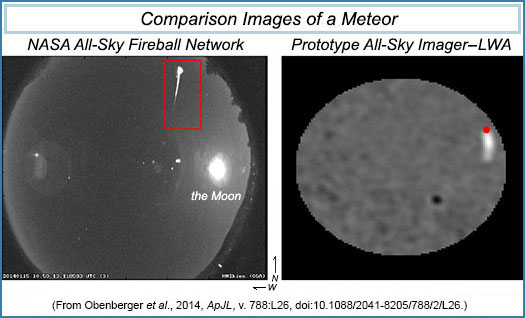Quick Views of Big Advances
Meteors Generate Radio Emissions
For the first time, meteors have been correlated in time and location in the sky with radio transients at frequencies of 25.6, 29.9, 37.8, and 37.9 MHz. Ten radio transients—radio emissions lasting tens of seconds—discovered in 11,000-hours-worth of all-sky images recorded by the Prototype All-Sky Imager (PASI) of the Long Wavelength Array (New Mexico) have been correlated to large, energetic meteors (average velocity of 68 km/sec). The research team, led by Kenneth Obenberger (University of New Mexico) and colleagues at UNM, NASA Jet Propulsion Lab, Virginia Tech, US Naval Research Lab, and Long Island University, compared the radio transients with known radio frequency bright sources and interference but discounted these as sources of the randomly-positioned transient pulses. Comparison of the PASI data with detections from NASA's All Sky Fireball Network sealed the association to meteors. The two images below show a meteor observed simultaneously by the All Sky Fireball Network and the PASI–Long Wavelength Array.

|
[LEFT] Meteor (outlined in red rectangle) in a night sky image obtained from a camera at the NASA All-Sky Fireball Network station located in Mayhill, New Mexico. [RIGHT] Bright radio emission from the same meteor, acquired by the Prototype All-Sky Imager of the Long Wavelength Array. The image shows intensity of radio waves in the night sky to 25 degrees above the horizon at the circle's edge. The red dot notes the final location of the meteor. Both images are displayed in the same orientation. |
Specifically, Obenberger and coauthors suggest the meteors radiate energy at radio frequencies. As astronomers further investigate these radio emissions to learn more about the physics of meteors and the total amount of energy they radiate at radio frequencies, we gain a better understanding of the phenomenon of extraterrestrial material entering Earth's atmosphere (see a selection of PSRD articles listed below). And as everyone knows, after touchdown, the meteorites are extremely useful objects to get hold of.
![]() (pdf version)
(pdf version)
See Reference:
· Obenberger, K. S., Taylor, G. B., Hartman, J. M., Dowell, J., Ellingson, S. W., Helmboldt, J. F., Henning, P. A., Kavic, M., Schinzel, F. K., Simonetti, J. H., Stovall, K., and Wilson, T. L. (2014) Detection of Radio Emission From Fireballs, The Astrophysical Journal Letters, v. 788:L26, doi: 10.1088/2041-8205/788/2/L26. [ abstract ]
· Long Wavelength Array–live radio cam
See PSRD articles
· A Summer Fall: The Tissint Martian Meteorite
· Asteroid, Meteor, Meteorite (Almahata Sitta)
· Meteorite Shower in Park Forest, Illinois
· Tagish Lake – A Meteorite from the Far Reaches of the Asteroid Belt
· The Surprise Meteorite Fall in Russia, February, 2013
Written by Linda Martel, Hawai'i Institute of Geophysics and Planetology, for PSRD.
|
|
[ About PSRD | Archive | CosmoSparks | Search | Subscribe ] [ Glossary | General Resources | Comments | Top of page ] |
